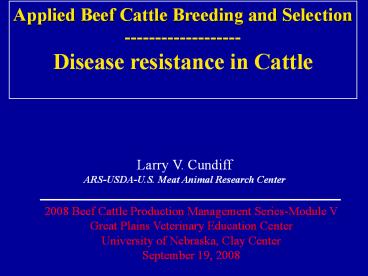Applied Beef Cattle Breeding and Selection PowerPoint PPT Presentation
1 / 11
Title: Applied Beef Cattle Breeding and Selection
1
Applied Beef Cattle Breeding and
Selection ------------------- Disease resistance
in Cattle
Larry V. Cundiff ARS-USDA-U.S. Meat Animal
Research Center
2008 Beef Cattle Production Management
Series-Module V Great Plains Veterinary Education
Center University of Nebraska, Clay
Center September 19, 2008
2
Mastitis in dairy cattle
Heritability .10 to .20 ( Miller
1982) Attention given to somatic cell count In
selection of dairy cattle. Bovine major
histocompatability complex (BOLA) genotype has
been associated with incidence of mastitis (Solbu
et al., 1982) W2 highly resistant to
mastitis W16 susceptable to mastitis
3
Infectious bovine keratoconjunctivitis (IBK),
pinkeye
Heritability .22 (Snowder et al., 2005)
- Incidence fluctuates greatly from year to year
( over 20 year period, lt 1 to 25 per year,
generally lt 10) - Incidence can be greater in Herefords than
other breeds (Frisch 1975 Webber and Selby,
1981 Snowder et al., 2005) - Incidence may be associated with greater
homozygosity in Herefords
4
Bovine Respiratory Disease (BRD) (Snowder et al.,
2008)
Postweaning (18,112 records) - Incidence ranged
from 5 to 42 in 14 year period from 1987 to
2001. Heritability .08 Incidence post
weaning (Snowder et al., 2008) Mean incidence by
breed (deviation from Angus) Angus
0.00 Hereford 4.23 Charolais 2.72
Gelbvieh 4.09 MARC I 1.90 MARC
II 3.68 MARC III 1.08
Differences between breeds were not significant
(P gt .05)
5
CHARACTERISTICS OF FIVE SELECTION LINES FOR HIGH
(H) VERSUS LOW (L) ANTIBODY PRODUCTION IN MICE
(Biozzi et al., 1982)
Immuni- No. gen.
Est. No. Antigens
zation to sel. Diff.
Herit- independ. Sel. used
proc. limit (H/L)
ability loci
I Sheep eryth. Primary 16 220
fold .20 9-11 Pigeon eryth. response II Sheep
eryth. Primary 13 103 fold .21 2-8 III Salm.
typh. Secondary 16 90 fold .20 4-7 IV Salm.
typh. Secondary 12 85 fold .21 2-4 V Bov. Ser.
Alb. Heperimmun 7 310 fold .22 2-4 Rabbit
gamma alum precip. globulin antigen
6
SUMMARY OF RESULTS ON RESISTANCE OF HIGH (H) AND
LOW (l) MICE TO VARIOUS INFECTIONS (Biozzi et
al., 1982)
Degree of resistance
Infection Innate resistance
Acquired resistance
H L
H L
F berghei - - Antibody T.
Cruzi - n.d. -
dependent N. dubius - -
immunity Rabies virus - - T
Spiralis
S typohimurium Macrophage T.
pestis
dependent B. abortus
suis immunity L
tropica n.d. n.d. S. mansoni
7
Conclusions of Biozzi et al.
- High response lines were more resistant to
infections dependent upon antibody immunity. - Low lines were more resistant to infections
dependent on macrophage immunity. - In most cases the line that was spontaneously
more resistant also was protected by vaccination
to a higher degree.
8
All types of mild endemic infections
macrophage dependent immunity
antibody dependent immunity
Severe epidemic infections
Severe epidemic infections
H X L cross F2 hybrids
Antibody responsiveness
Macrophage activity
Theory for evolution of host parasite interaction
in genetically heterogeneous populations
according to inverse polygenic control of
antibody production and macrophage activity
(Biozzi et al., 1982)
9
All types of mild endemic infections
All types of mild endemic infections
All types of mild endemic infections
Severe epidemic infections
Severe epidemic infections
Severe epidemic infections
H X L cross F2 hybrids
Under Severe Epidemic Infection dependent on
macrophage immunity Favors AA genotypes,
extreme individuals (aa) would be eliminated and
heterozygotes (Aa) would also be susceptible to
elimination.
10
All types of mild endemic infections
All types of mild endemic infections
All types of mild endemic infections
Severe epidemic infections
Severe epidemic infections
Severe epidemic infections
H X L cross F2 hybrids
Under severe epidemic infection dependent on
antibody immunity Favors aa genotypes, extreme
individuals (AA) would be eliminated and
heterozygotes (Aa) would also be susceptible to
elimination.
11
All types of mild endemic infections
antibody dependent Immunity (favors aa genotypes)
macrophage dependent Immunity (favors AA
genotypes)
Severe epidemic infections
Severe epidemic infections
H X L cross F2 hybrids
Antibody responsiveness
Macrophage activity
Under mild endemic infection Favors Aa
genotypes, extreme individuals (AA or aa) would
be eliminated by susceptability to diseases
dependent on macrophage (or antibody) immunity.
12
Effects of different degrees of dominance on
phenotypic value
No Dominance (additive)
Partial dominance
Complete dominance
Over- dominance
13
Theory of host parasite interaction
- Theory is consistent with effects of heterosis
and benefits of crossbreeding - Unfortunately, selection for resistance to a
specific disease may lead to resistance for one
group of diseases but susceptibility for another
group of diseases. - Specialized paternal and maternal lines may be
best answer. - With aid of vaccination procedures in parental
seedstock populations and DNA marker assisted
selection, - It may be possible to select for one type of
disease resistance in paternal lines and another
type of disease resistance in maternal lines. - Then genetic resistance could be realized with
vast majority of cattle produced commercially by
mating complementary maternal and sire breeds.

